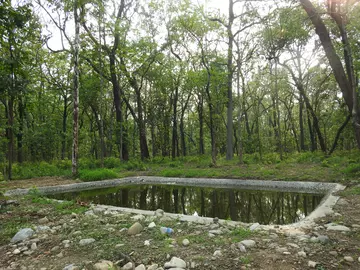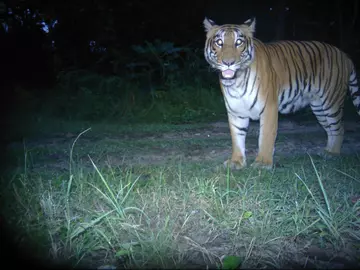
ZSL
Zoological Society of London
ZSL Office in Nepal gives an account of how habitat restoration has enabled a tiger population to treble in five years.
Before 2015, Halkhoriya Lake and its associated Bara forests were plundered for natural resources, and wildlife was close to being obliterated from the site. However, in 2015, the Government of Nepal annexed this lake and forests (referred to as the Extension Area) into Parsa National Park. While the announcement of the Extension Area was in itself a major achievement, years of unsustainable practices had left the area in urgent need of restoration.
Creating an appropriate habitat
In close coordination with the park authorities, ZSL-Nepal has worked tirelessly for this restoration. Habitat management practices such as grassland management are restoring grazing sites for ungulates and other prey species. Halkhoriya Lake has been rescued from being converted into a 15-ha swamp: earth excavation, removal of grasses and other woody plants, construction of wildlife-friendly muddy embankments, rerouting of a small perennial stream, and outlet construction to allow overflow downwards have all helped restore the wetland habitat.

Likewise, the mobilisation of more than 1,000 security forces including the Nepal Army and Community Based Anti-Poaching Units, and the construction of five additional guard posts during 2016-2018 have had a major impact on the critical recuperation of wildlife. The deployment of GSM-enabled surveillance cameras, SMART patrols, CCTV monitoring, and Rapid Response Teams have also provided wildlife with an extra layer of protection. Furthermore, camera traps continue to assess the situation of wildlife in the area, providing valuable information on habitat use, species density and hotspots. All these interventions have once again made the Extension Area a haven for wildlife.
The tiger is a conservation-dependent species, and as a result, it responded to our interventions right away. By being able to fulfil its basic needs, we were able to increase the tiger population in the park three-fold since 2014, verified by our monitoring. Wildlife biologists working in the area believe that this increase is due to the dispersal of tigers from neighbouring Chitwan National Park, which has been confirmed from the comparison of individual tiger profiles between the two parks.

Parsa, which has historically been a sink for tiger populations, witnessed a landmark event when four years after the extension of the National Park, one of the camera traps photographed a female tiger with three cubs near Halkhoriya Lake, in the Extension Area. This is a concrete reminder that intervention activities can work wonders if applied responsibly.
Looking ahead
Now that the Extension Area has finally seen tigers breeding within its boundary, the question naturally arises: where do these cubs go once they reach adulthood? Tigers will disperse in search of suitable territories, consequently putting them and the villages in their path at direct risk from each other. Therefore, despite the breeding success, the future of the cubs remains uncertain.

Fortunately, ZSL-Nepal, through its effective monitoring has been able to assess the tiger’s activities in the park, helping the park authorities identify issues and make appropriate interventions. While we are striving to ensure that every cub born in the park has a future, we also recognise the immensity of the challenge. As such, we need every bit of support that we can muster so that we can build a future of harmonious co-existence between tigers and human beings.
This work was made possible by grants from: IUCN-KfW, Panthera and WildCats Conservation Alliance.
